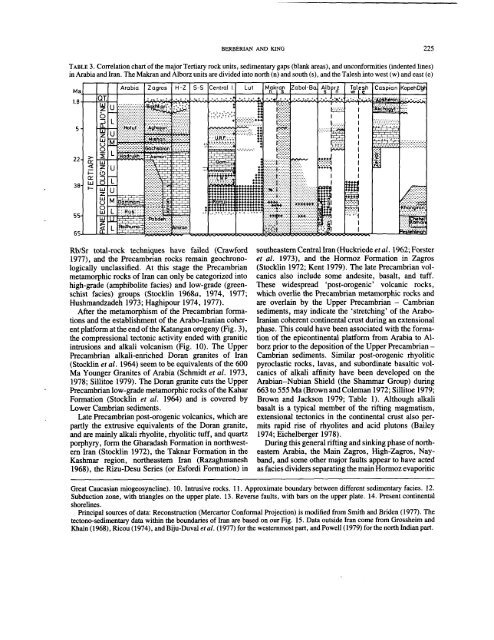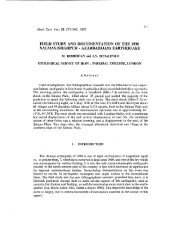PDF COPY - Manuel berberian
PDF COPY - Manuel berberian
PDF COPY - Manuel berberian
You also want an ePaper? Increase the reach of your titles
YUMPU automatically turns print PDFs into web optimized ePapers that Google loves.
BERBERIAN AND KING 225<br />
TABLE 3. Correlation chart of the major Tertiary rock units, sedimentary gaps (blank areas), and unconformities (indented lines)<br />
in Arabiand Iran. The Makran and Alborz units are divided into north (n) and south (s), and the Talesh into west (w) and east<br />
S-S Central I. Lut Make’an Zabol-Ba<br />
~b iJrnz ~ TaleShwl$ Caspian KopehD~<br />
÷ ~ ._-..-.:..-~<br />
Rb/Sr total-rock techniques have failed (Crawford<br />
1977), and the Precambrian rocks remain geochronologically<br />
unclassified. At this stage the Precambrian<br />
metamorphic rocks of Iran can only be categorized into<br />
high-grade (amphibolite facies) and low-grade (greenschist<br />
facies) groups (Stocklin 1968a, 1974, 1977;<br />
Hushmandzadeh 1973; Haghipour 1974, 1977).<br />
After the metamorphism of the Precambrian formations<br />
and the establishment of the Arabo-Iranian coherent<br />
platform at the end of the Katangan orogeny (Fig. 3),<br />
the compressional tectonic activity ended with granitic<br />
intrusions and alkali volcanism (Fig. 10). The Upper<br />
Precambrian alkali-enriched Doran granites of Iran<br />
(Stocklin et al. 1964) seem to be equivalents of the 600<br />
Ma Younger Granites of Arabia (Schmidt et al. 1973,<br />
1978; Sillitoe 1979). The Doran granite cuts the Upper<br />
Precambrian low-grade metamorphic rocks of the Kahar<br />
Formation (Stocklin et al. 1964) and is covered by<br />
Lower Cambrian sediments.<br />
Late Precambrian post-orogenic volcanics, which are<br />
partly the extrusive equivalents of the Doran granite,<br />
and are mainly alkali rhyolite, rhyolitic tuff, and quartz<br />
porphyry, form the Gharadash Formation in northwestern<br />
Iran (Stocklin 1972), the Taknar Formation in the<br />
Kashmar region, northeastern Iran (Razaghmanesh<br />
1968), the Rizu-Desu Series (or Esfordi Formation)<br />
......................, v U.R.~.,.~.~., **** k:::--:5:,’""~<br />
~ ~- ~ ~. ~. ~- ~ ~- ~- ~- %* .....<br />
::::::::::::::::::::::::::::::: - ÷ ¯ ~--:.!i<br />
~::-’-’-’:-’-’: ~<br />
- ÷i ::::::::::::::::::::::::::::"::’:’:"<br />
"~ "" .....<br />
-~.’° ,...:<br />
............. .~.-~<br />
t’~÷*’,. ~ ..:._ "~ ............<br />
oo÷, .÷÷, ÷.. ÷÷’ ÷’<br />
I<br />
÷’ ::::::::::::::::::::::::::::<br />
}::::::}::::}i<br />
i Iil<br />
}}}<br />
¯ ....,÷÷o,°~a*’ ..............<br />
~.÷++÷÷++÷~ .÷÷÷÷o÷÷,:i:~r":::i:i:i:!:~






